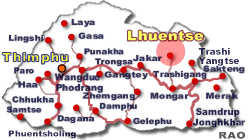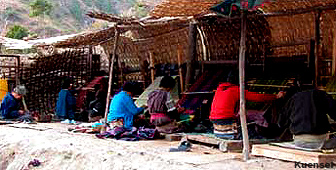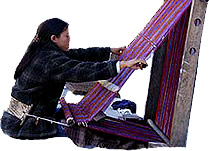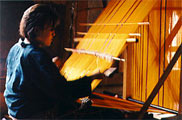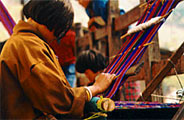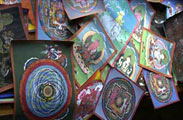After the agriculture season is over and the cold months set in, women in groups of six to ten set up their backstrap looms in rows in the harvested paddy fields and weave, sheltered by bamboo canopies from three sides with their backs exposed to the sun. "It gets cold inside the house during winter," said Yangchen Lhamo, 21, who have been weaving for the last 14 years. "We prefer not to use heaters or bukharis (wood fed stoves) to save wood and cut down on electricity bills." In Khoma village, the heart of the weaving tradition of Khoma geog, about five groups of weavers get to work at different locations in the village. Some households have about three to four women weaving the kushuthara.
It is customary for all Khomap women to know and learn the finely honed art of weaving the kushuthara that has been passed down from generation to generation. Young girls learn the skill at the age of seven or eight. "All the women in Khoma can weave the kushuthara. There is no exception for our younger ones," said Tshering Paydon"s mother, Yangzom, 28. "Even I learnt weaving when I was just seven years old, and so did all the other women here." She added that weaving was an important source of income for most women in Khoma. As beginners, the young girls learn to weave on cotton fabrics using silk threads for the intricate designs seated beside their mothers who direct them. "We allow them to weave very simple designs," said Yangzom. Completion of every weave sets a new course for the young girls to weave different patterns and designs. "I was never interested in studying, I preferred weaving instead," said Yangchen Lhamo who dropped school after class nine. "Weaving the kushuthara is challenging because every time I finish one bup (or three woven warps that make a kira piece) I learn to create other new designs, unique from those I had woven earlier." Each kushuthara has the signature of its weaver who designs patterns depending on the occasion that the kushuthara is to be worn for. For more important occasions more intrinsic and dense are the patterns. Aum Karma, 45, who had taught all her four daughters to weave said that she preferred her daughters weave than attend school. "They barely make it up to the twelfth standard and get a job earning just about Nu. 3,000 to Nu. 4,000 a month," said Aum Karma. "It is better to keep them home, enhance their weaving skills with which they will be able to earn about Nu. 30,000 to Nu. 40,000," said Aum Karma. "Every now and then I get orders from buyers in Thimphu and I can easily sell it to them." But learning to weave a kushuthara is not easy. There are a number of procedures involved before weavers can finally get started. They have to first learn to boil the silk in a citric (khomang) mixture to retain the original colour of the silk, before drying it in the sun. The dry silk is then spun into a ball to form a continuous yarn which is stretched on two stands before it is finally spread out vertically on the thakshing (loom). "Getting into the actual task of weaving is eye straining, sewing up designs on the fabric for more than 12 hours a day," said Yangzom. Most weavers are able to weave only about two inches every day depending on the intricacies involved in the designs, which also determines the cost of the weave. "It takes us more than a month to complete one piece," said Yangzom. "But we try to finish one set within three months." The women start weaving in December and strive to finish by the end of February before farm work comes calling. Most of the kushuthara weaves get sold in February, March and August, the festivals months in Thimphu and Paro and also the tourist seasons. "Most of our customers are foreigners and people from the western part of the country," said Aum Karma Zangmo, 44, from Trashigang who has been in Khoma for the last seven years and can weave buray and lungserma besides kushuthara. "During those months people from Thimphu came to Khoma just to buy their kiras. That is when we sell the most," said Aum Karma who said that demand for kushsuthara was not like in the past. "Sometimes we land up keeping the kira for ourselves to wear during occasions." The good designs with striking colours sell for about Nu. 30,000 to Nu. 40,000, while the light colour with simple designs sell for about Nu. 19,000 to Nu. 20,000. The money earned is used for buying raw silk from Phuentsholing, Samdrup Jongkhar or Mongar which cost about Nu. 3000 a kilogramme and about two kilogrammes of silk go into making a kira. The money is also used for buying their children"s school uniforms and meat and butter for a grand family feast. The
men, while the women are weaving take up carpentry. They are often seen
sitting among the women or walking into the forest to fetch wood or collecting
fodder for their cattle. Every now and then, they walk to Lhuentse, which
is about an hour and a half walk from Khoma, to buy salt, sugar and oil,
while shopkeepers bring back cases of beer and packet noodles. When the
cold months warm up, both the men and women folk engage themselves in their
farms where they grow rice, maize and millet. The men remain in the fields
from early morning till sundown, but the women return home earlier and
continue weaving the kushuthara with the free time they find in the evening.
There are three types of kushuthara:
The white kushuthara is more in demand all over the country. The black one is usually preferred by tourists and the arshom by customers in western Bhutan.
|


